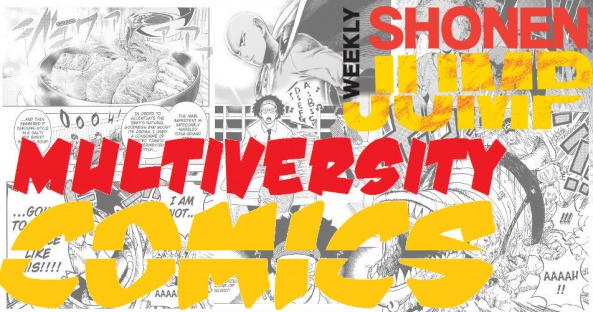
Welcome to This Week in Shonen Jump, our weekly check in on Viz’s various Shonen Jump series. Viz has recently changed their release format, but our format will mostly remain the same. We will still review the newest chapters of one title a week, now with even more options at our disposal. The big change for our readers is that, even without a Shonen Jump subscription, you can read these most recent chapters for free at Viz.com or using their app.
This week, Vince checks in with “The Elusive Samurai.” If you have thoughts on this or any other current Shonen Jump titles, please let us know in the comments!
The Elusive Samurai – Chapter 1: The Slaughter of 1333
Written & Illustrated by Yusei Matsui
Review by Vince J Ostrowski
From the creator of “Assassination Classroom” comes something radically different, but just as thoroughly conceptualized and prestigious in quality. “Assasination Classroom” balanced wacky humor with scholarly Japanese satire and emotional baggage that piles up chapter after chapter. “The Elusive Samurai” doesn’t appear to be attempting satire, and there’s very little humor to be found, but what you get instead is an opening chapter that comprehensively unfolds a conflict of historical samurai fiction in a way that is gut-wrenchingly tragic and violent. Our young hero is Hojo Tokiyuki: a young heir of the Hojo clan, leaders of the Kamakura shogunate. Matsui-san packs a lot of story into this oversized chapter, giving us a rich backstory for Tokiyuki’s family situation. His father is ill, effectively non compos mentis, and commands the shogunate as a puppet of his advisors who really run things behind the scenes. His brother is technically older, but honor codes make him unfit to be the heir. So, at a mere 10 years old, the weight of expectations have been laid upon him to train for his coming duties as commander of the shogunate. This all runs contrary to his nature, as the title of the series indicates, which is that of a boy who looks to elude, run, and otherwise hide, before entering a battle. Matsui does a keen job of laying out Tokiyuki’s character, ensuring that the reader understands that he is not a coward and isn’t living in fear, but is something of a pacifist, at least compared to the other great warriors of the shogunate as depicted here. He values preserving his life and the lives of others through elusion and strategy over fighting. Matsui also does a decent job of depicting with accuracy the unique samurai code of honor that the shogunate would likely adhere to. This is a complicated and dated topic that uninitiated readers might not fully grasp. I’m not sure if “The Elusive Samurai” clearly explains the code, but the way tragedy ends up striking the clan and the fallout therein is clear enough through inference, I think.
And what a tragedy it is. I don’t dare spoil it here, but the big twist happens exactly halfway through the chapter, and was difficult for me to see coming. Up to this point in the chapter, I admit that the story was a little too dry. In fact, at one point it feels like we’re being given the same information about our main character for the second time, making me wonder if the padded page count of this opening entry was a factor. I applaud the careful detail and the feeling of period accuracy in the story, but it does result in a chapter that doesn’t find its soul until the back half. The characters really open up and start to reveal themselves, the main cast begins to form, and the story moving forward becomes clear. It’s tough to criticize the opening half of the chapter, as it’s contextually necessary, but I can’t help but feel like the characters coming together felt rushed because of that.
I’m also not sure that the characters are visually unique enough to be memorable. Like the school kids in “Assassination Classroom”, once you get more invested in the series, you’ll know them better on sight. While the characters are all very handsomely rendered, only a particularly majestic adult samurai character who plays a major role in the story has design work that I can easily recall now. The action is particularly good, the setting and costuming are appropriately detailed, and the way the violence is depicted really lends heft to the proceedings. Unlike its main character, “The Elusive Samurai” doesn’t shy away from the brutality, but it also doesn’t go over the top or get wacky with it. The bloody nature of the tragedy is very matter-of-fact, but certainly grabs the reader’s attention. It’s a pivotal series of moments, and as a consequence they actually end up outshining the rest of the chapter.
Final Verdict: 7.0 – This oversized opening chapter is a beautiful looking and promising start for “The Elusive Samurai”, but perhaps too much of a slow, dry burn to hold the attention of some readers






